In arid desert regions, a large proportion of the ground surface is covered by specialized organisms such as mosses and lichens that form biocrusts, which are important for the cycling of key nutrients in desert ecosystems. However, the long-term effects of warming and drought on these key biotic components of desert ecosystems remain poorly understood. Therefore, it is necessary to explore the response and adaptation mechanism of desert system to climate change.
Recently, a research team led by Prof. Li Xinrong from the Northwest Institute of Eco-Environment and Resources (NIEER) of the Chinese Academy of Sciences (CAS) evaluated how both lichens and mosses in biocrusts communities responded to 0.5℃ and 1.5℃ increases in temperature coupled with 5% and 8% reductions in total annual precipitation.
A 12-year manipulative experiment was carried out in the Tengger Desert, Northwest China. Two groups of open-top chambers were used to simulate the predicted climate change conditions, and the effects of surface soil carbon uptake by biocrusts were evaluated.
Results indicate that the 12 years of warming coupled with increased drought resulted in a significant decrease in the cover and biomass of mosses but did not change the cover or biomass of lichens.
This study suggests that coupled warming and drought conditions could increase the dominance of lichens in biocrust communities to partly maintain the multifunctionality of biocrusts in this desert ecosystem.
This study has been published on Agricultural and Forest Meteorology , titled “Divergent responses of moss- and lichen-dominated biocrusts to warming and increased drought in arid desert regions.”
Changing temperatures and precipitation may affect living skin of drylands
More information:
Xinrong Li et al. Divergent responses of moss- and lichen-dominated biocrusts to warming and increased drought in arid desert regions, Agricultural and Forest Meteorology (2021). DOI: 10.1016/j.agrformet.2021.108387
Provided by
Chinese Academy of Sciences
Citation:
Scientists reveal responses of different biocrusts to warming and increased drought (2021, March 17)
retrieved 17 March 2021
from https://phys.org/news/2021-03-scientists-reveal-responses-biocrusts-drought.html
This document is subject to copyright. Apart from any fair dealing for the purpose of private study or research, no
part may be reproduced without the written permission. The content is provided for information purposes only.



